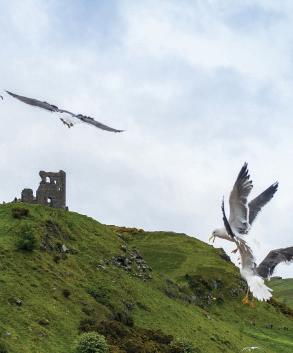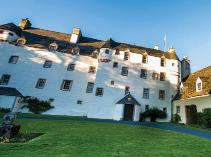
6 minute read
TAKING SCOTLAND IN
When I first learned I would be taking a walking trip, I immediately envisioned a marathon event – and the picture was not a pretty one. I imagined long days focused on getting to the destination, enduring challenging climbs and seemingly endless roads and breathless moments where I worried I might not be able to keep up. It didn’t comport with my vision for how I usually go about exploring new places and sampling new cultures.
However, after two back-to-back trips with The Wayfarers Walking Vacations in Scotland last June, I consider myself a convert to this form of travel. Whether in the Highlands or the Borders, we walked through time, deeply engaging with the historical and current culture of these distinct regions and then with each other in rich exchanges and heartfelt camaraderie.
Even as a travel photographer who has chased stories on remote trails and distant tarmacs for most of my years, the two trips were a bit ambitious: participants on these tours nearly always book only one itinerary at a time.
Averaging 10 miles a day, the tours were packed with gorgeous vistas, historical sites and local lore at every turn. Despite the beauty, however, it was the camaraderie kept us going. My fears to the contrary notwithstanding, competition was never in play. Everyone was supportive and each went at his or her own pace.
One person from each trip usually percolated up to the front of the line – intense walkers who took even the steepest passages with ease.
Nor was age a factor; We had some life-long walkers whose walking sticks seemed natural extensions while they ventured forth, while others who were new to this mode of travel got to know their own bodies while exploring new surroundings. S IS FOR SCOTLAND
If you come away with any memories in particular they will likely involve salmon, sheep and sky, whether in the highlands or borderlands. These include patient, solitary moments of fly-fishing along the Tay, Tummel and Tweed rivers. Who knew there were seven names for the seven stages of life for salmon?
Sheep of several varieties dotted the countryside. These pastoral scenes evoked simpler times – until the AV/4 wheelers came bounding up the hill with several dogs in tow nudging the herds from one pasture to another. In the villages along the borders we heard stories about the Reviers – violent gangs of thieves in the night who take advantage of the lingering darkness to steal away entire herds of sheep and cows to fence to the highest bidder.
While a tour through Highlands might be spent walking through forests, from the impressive Caimgorn Mountains to the Glen Tilt, a walk through the Borders in Scotland was defined by wide open vistas. Under these endless skies were the soft stands of the Athol Forest and Highland Perthshire – through the centuries thousands of acres here were used to grow timber for masts that made the British Navy ships among the most formidable in the world.
And in the way of the Dukes and Earls of Athol, we found ourselves enjoying a respite in the well-appointed Blair Castle and surrounding garden. We also walked back in time to view the ruins of the 14th century Black Castle near Pitlochry and the 180-foot Black Spout Waterfall before descending into more woods and forests.
All this was followed by a wee bit of whisky and a steaming bath to soak tired muscles. Unlike the more seasoned walkers, perhaps, I needed this nightly respite to face the next day’s route.
One of those days meant travelling the Scottish Upland Way, which runs coast to coast with steep climbs. We started in Yarrowford and began our ascent immediately. This was not for the



PREVIOUS PAGE: A walk to the village of Moulin, ruins of Black Castle, River Tummel, and Pass of Killiecrankjie FROM TOP: Walk to Abbotsford, the baronial mansion of Sir Walter Scott, Neidpath Castle being serenaded by bagpipes; Edinburgh hike walking up Arthur's Seat; the historic Traquair House; walk around the famous Melrose Abbey weak hearted – or weak kneed. We walked past felled woods and places where replanting was taking place to recapture the original beauty that John Buchan, naturalist, author and first baron of Tweedsmuir, catalogued during his prolific writing career.
Each night we made our way to a new country house, starting with the Muckrach Country House Hotel in the Highlands. Here Dougal and Hamish, the permanent Highland bull residents, do the greetings. Highland cattle were originally bred in the Scottish Highlands and the Western Isles of Scotland dating back to the eighteenth century. These patient bulls loved nothing more than being fed an oatcake biscuit by new guests and hanging out with Harry the hotel dog.
In the Borders area a highlight was staying at Windlestraw Hotel, a stately Edwardian manor overlooking the Tweed Valley. Upon arrival we were served a full afternoon tea in the living room before retiring to comfortable stately quarters.
In between stays and walks, special guests showed up to offer context and depth to our daily meaderings. Some key highlights included a surprise visit by noted historical author Alistair Moffet and another from Catherine Maxwell Stuart, a direct descendant of King James VI and current continuous resident of the Traquair House. This ancient manor dates back to 1107 and has been continually lived in by the Stuart family since 1491.
In Peebles, as we followed the ancient route of drovers, we traversed the river to the 800-year-old Neidpath Castle trailed by the floating bellows of bagpipes. The tour of this lumbering castle seemed to defy the present as we wandered the various levels in a visit that ended with a theatrical presentation of Walter Scott’s 1816 tale, The Black Dwarf at the private baronial mansion, Glenternie House.

WILL WALK FOR FOOD
From the made to order hot Scottish full breakfasts to delightful and luxurious meals in a variety of unique settings, to the final night of the Highlands trip dining on a degustation and whisky pairing in Edinburgh, the food was, every day, our deserved and delicious reward. Delicious fresh fruit and tasty local snacks would be served picnic style in the back of the Wayfarers van that would miraculously appear at just the right time.
Any visit to Scotland should include the sampling of haggis, fresh fish, lobster, grouse, a bowl of Cullen skink, cured meat and cheeses, porridge, perhaps shortbread and plenty of whisky.
Wayfarers Walking Tours continues to operate during these COVID times. However, to manage these tours the company now limits the number of participants on each trip and the number of passengers per nine-seater Mercedes Sprinter van to six. Facial masks are required during travel, although not while walking outside. Van interiors are continuously sanitised and social distancing is respected at all times.
As walking tours have become particularly popular during the pandemic, US travellers who might not be able to get to Europe at this time can join in Wayfarer walking tours on this side of the Atlantic. Destinations include the Berkshires in western Massachusetts, southern Arizona, parklands in Utah and Acardia National Park in Maine.
Another option is to plan a customised walking tour with a Wayfarer guide to light the way for a family or pod to explore new places, get fit and have fun without worry.
Caveat: bring a second pair of walking shoes and your favourite bath salts.










